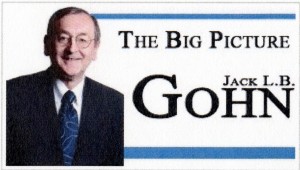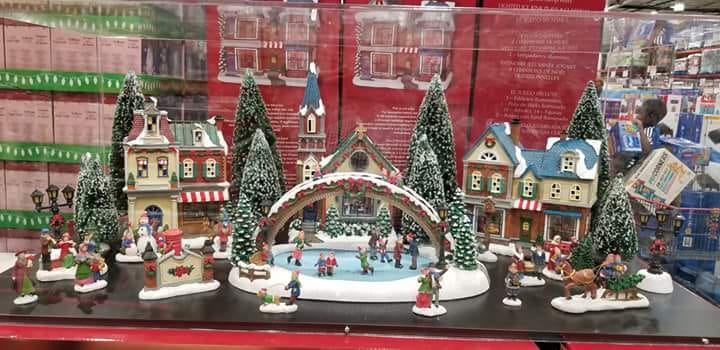Every One of Them White
The Big Picture Home Page | Previous Big Picture Column | Next Big Picture Column
Every One of Them White

To be published in The Daily Record the week of October 28, 2018
“Enjoy glimpses reminiscent of traditional holidays gone by with this highly detailed Holiday Village Set,” says the ad copy on the Costco website.[1] For $99.99, Costco will sell you an assemblage of models of various snow-topped buildings, a skating rink, trees, and lots of merry-makers, including carolers and musicians and children putting the finishing touches on a snowman. The dress of these happy figures is, I’d guess, late Victorian. It is a Currier & Ives evocation of an imagined past, a bit of cute and harmless nostalgia.
What Genius?
Except: By my count, there are 35 merry-makers depicted in the set, every one of them white. (And I’m not counting the snowman.) What genius among Costco’s buyers missed the impact of a representation like this in today’s marketplace? How did it happen?[2]
My answer: There is a deep dynamic at work here, rendering what should have been obvious quite overlookable. When we white folks retreat into a happy recall of eras gone by, we regularly evict nonwhites from the world our imagination reconstructs. Take the classic nostalgic musicals Oklahoma! and The Music Man. As discussed by Warren Hoffman in his book The Great White Way: Race and the Broadway Musical, each of these is set in what appears to just happen to be an all-white locale. But nothing “just happens” like that.
Oklahoma, the name of the territory whose newly-established statehood is celebrated at the end of Oklahoma!, is literally the Choctaw word for “red people.” The farmers and cowboys evoked by the show had historically displaced and were living, often illegitimately, on lands set aside for Native Americans, after the latter had been previously deported to Oklahoma during the notorious “trail of tears” ethnic cleansing of the American South. As Hoffman puts it: “Oklahoma! rewrites history by expunging the painful aspects of frontier history while celebrating the rewards of white American pioneer spirit, features that have helped solidify Oklahoma!’s place in the pantheon of beloved American musicals.”[3]
And The Music Man is set in “Hawkeye Iowa,” “hawkeye” being ironically a nickname coined to pay tribute to a Sauk tribal chief. Iowa was a state from which Native Americans were forcibly removed, ironically making it safe for the show to evoke them by having the white wives of the town perform an “Indian war dance.” And of course there is the famous lyric in which the con man tries to rile up the River City townspeople by warning them that their children may be becoming fans of “ragtime,” obviously coded as African American music. But of course that fear is groundless; River City is and will remain lily-white, its whiteness exerting a potent if unspoken part of its grip on our imagination as a piece of unspoiled Americana.[4]
There Is Harm
One could ask what is the harm in a fantasy retreat into an exclusively white world. It’s what we do, not what we feel, that matters, right?
But there is harm. As educator Robin DiAngelo writes in her book White Fragility: “As a white person, I can openly and unabashedly reminisce about ‘the good old days.’ Romanticized recollections of the past and calls for a return to former ways are a function of white privilege, which manifests itself in the ability to remain oblivious to our racial history.” DiAngelo reminds us of the facts that would make incorporating non-white people into this fantasy discordant – and forgive me for quoting at length: “Consider any period in the past from the perspective of people of color: 246 years of brutal enslavement; the rape of black women for the pleasure of white men and to produce more enslaved workers; the selling off of black children; the attempted genocide of Indigenous people, Indian removal acts, and reservations; indentured servitude, lynching, and mob violence; sharecropping; Chinese exclusion laws; Japanese American internment; Jim Crow laws of mandatory segregation; black codes; bans on black jury service; bans on voting; imprisoning people for unpaid work; medical sterilization and experimentation; employment discrimination; educational discrimination; inferior schools; biased laws and policing practices; redlining and subprime mortgages; mass incarceration; racist media representations; cultural erasures, attacks, and mockery; and untold and perverted historical accounts, and you can see how a romanticized past is strictly a white construct.”[5] What does it say about us if we really want to fantasize a world exclusively populated by people who perpetrated these things?
Hollywood, the dream factory par excellence, has traditionally reinforced the fantasy as well. We need only remember the #OscarsSoWhite controversy of 2016, when there was not a single acting Academy Award nomination (out of 20) for a performer of color, to see how current the avoidance of nonwhites in our fantasy lives is.
Comfort Zones
The fantasy affects real life. In Baltimore, where I live, racially restrictive covenants for some of the “best” neighborhoods, i.e. ones approximating most closely our collective versions of the American dream, assured that those fantasies-come-to-life would be uncontaminated by the intrusion of nonwhite faces, except in the roles of domestic help. (Antero Pietila’s book Not in My Neighborhood tells the tale.) Those covenants have been stricken down, but “white flight,” the retreat of white populations to rural settings or suburbs, coupled with the mortgage redlining DiAngelo mentions (now officially a thing of the past but still sometimes practiced) which penned black homebuyers in urban cores, has continued to enable the fabrication away from urban centers of close approximations of the monochromatic racial culture the Costco holiday village so ludicrously evokes.
It is important to emphasize that the dynamic is at play even among those of us who do not bear any ill-will to members of other races. Most of us genuinely reject bigotry. The pursuit of monochromatic worlds is mostly fueled by the pursuit of comfort, not by hatred. Our residential and educational practices betray unconscious and unacknowledged comfort zones. The holiday village demonstrates exactly what makes many of us comfortable. We white people need to break ourselves of those mental comfort zones, though, because we are powerful, and our dreams greatly affect what happens in real life. And what happens in real life, mostly, is segregation. We’ve changed the laws, but those changes have not brought us all that close to real desegregation; changes in our dreams and fantasies of a good life would do more.
Happy Holidays!
_______________
[1] https://www.costco.com/Christmas-Village-with-Lights-%2526-Music.product.100405000.html viewed October 12, 2018. I attach my own photo of the item as I saw it in the store.

[2] An earlier version of this piece read slightly differently. It assumed that the Holiday Village intended to depict an American scene and had erased all nonwhite participants in that scene. An astute reader pointed out that collecting Victorian (and hence presumably British) holiday villages is a common pastime. And indeed, upon further inspection, I note that among the figures in the Village are three urchins, presumably mailing requests to Santa, clustered around a pillar box of a design only found in the British Isles and Empire/Commonwealth. See the erudite Wikipedia entry on Pillar Boxes. While one could quarrel that the pillar box depicted is of a design that (per Wikipedia) premiered in 1905 and Victoria died in 1901, and that the dress of the villagers looks a little out of place in the 20th century — in other words, that there is some anachronism going on, my friend’s point is well-taken. This is probably an attempt to evoke a world that was predominantly white in a way that the United States of whatever era is being hearkened to was not, and so erasure of those historically present is not happening after all. My point about the tin ear of the Costco buyer in foisting this evocation upon Costco’s diverse customers in this diverse country and time stands, however.
[3] Hoffman, Warren. The Great White Way: Race and the Broadway Musical (p. 66). Rutgers University Press. Kindle Edition.
[4] See the discussion in Hoffman’s book at 93-95.
[5] DiAngelo, Robin J.. White Fragility: Why It’s So Hard for White People to Talk About Racism (p. 59). Beacon Press. Kindle Edition.
Copyright (c) Jack L. B. Gohn
The Big Picture Home Page | Previous Big Picture Column | Next Big Picture Column